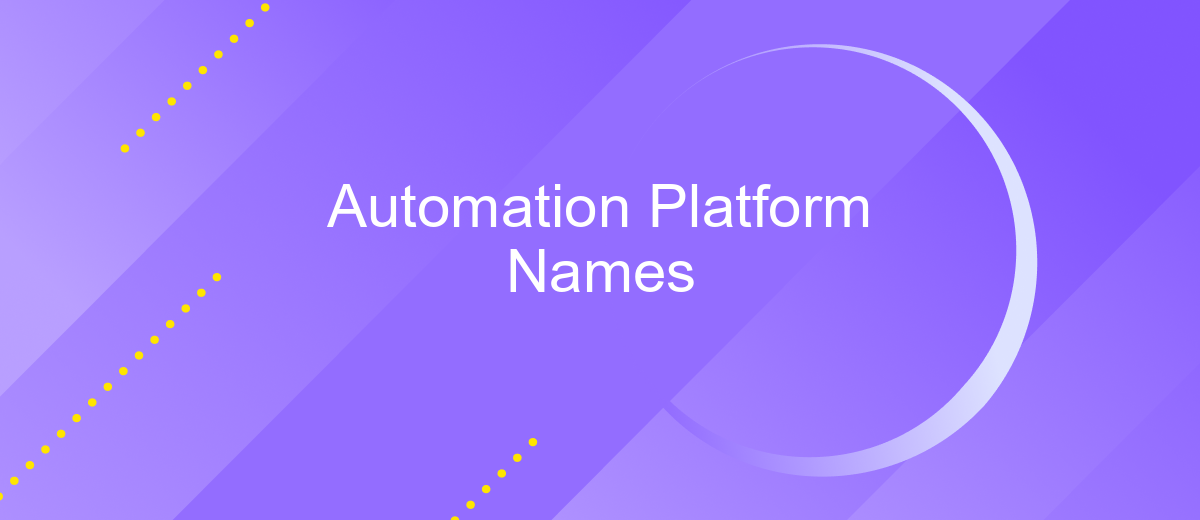Automation Platform Names
Choosing the right name for an automation platform is a crucial step in establishing its identity and market presence. A well-chosen name can convey the platform's purpose, ease of use, and innovative capabilities, making it more appealing to potential users. This article explores effective strategies and creative approaches to naming automation platforms, ensuring they stand out in a competitive landscape and resonate with their target audience.
Name
Choosing a name for your automation platform is a critical step in establishing its identity and market presence. A well-thought-out name not only reflects the core functionality of the platform but also resonates with the target audience, ensuring memorability and brand recognition. It should be unique, easy to pronounce, and relevant to the services provided by the platform.
- Reflective of functionality: The name should hint at the platform's capabilities and purpose.
- Memorable and catchy: A name that sticks in the mind of potential users aids in brand recall.
- Easy to pronounce: Simplicity in pronunciation ensures that users can easily discuss and recommend the platform.
- Unique and distinctive: A unique name helps in differentiating the platform from competitors.
- Scalable: The name should allow for future growth and expansion of platform capabilities.
Ultimately, the name of your automation platform should embody the essence of your product while being adaptable to future innovations. It serves as the first point of contact with potential users, making it a crucial element in the marketing strategy. A carefully chosen name can significantly contribute to the platform's success and longevity in the competitive tech industry.
Type

When exploring automation platform names, it is essential to understand the types of platforms available and their specific functionalities. Automation platforms can broadly be categorized into workflow automation, robotic process automation (RPA), and integration platforms as a service (iPaaS). Workflow automation focuses on streamlining business processes by automating repetitive tasks within an organization. RPA, on the other hand, uses software robots to mimic human actions, making it ideal for automating rule-based tasks in various industries. iPaaS solutions enable seamless integration between different applications, facilitating data flow and enhancing operational efficiency.
Integration platforms like ApiX-Drive play a crucial role in the realm of automation by providing tools to connect disparate systems effortlessly. ApiX-Drive stands out by offering a user-friendly interface that allows businesses to set up integrations without extensive technical knowledge. This type of platform supports a wide range of applications, ensuring that data can be transferred smoothly and securely. By leveraging such integration services, organizations can enhance their automation capabilities, reduce manual intervention, and improve overall productivity. Understanding these types of automation platforms can guide businesses in selecting the right solution for their unique needs.
Features

Automation platforms have become essential tools for businesses looking to streamline operations and increase efficiency. These platforms offer a variety of features designed to automate repetitive tasks, integrate with other systems, and provide valuable insights. The right automation platform can significantly enhance productivity and reduce operational costs.
- Task Automation: Automates routine and repetitive tasks, freeing up time for employees to focus on more strategic activities.
- Integration Capabilities: Seamlessly connects with other software and systems, ensuring smooth data flow and reducing manual entry errors.
- Scalability: Easily adapts to the growing needs of a business, allowing for the addition of new processes and users without significant changes.
- Analytics and Reporting: Provides detailed reports and analytics, offering insights into performance metrics and helping in decision-making processes.
- User-Friendly Interface: Features an intuitive design that requires minimal training, enabling users to quickly adapt and utilize the platform effectively.
Choosing the right automation platform involves considering the specific needs of your business and the features that will best support those needs. By leveraging these tools, companies can not only enhance their operational efficiency but also gain a competitive edge in their respective industries.
Benefits

Automation platforms are revolutionizing the way businesses operate by streamlining processes and enhancing productivity. These platforms enable organizations to automate repetitive tasks, allowing employees to focus on more strategic activities. As a result, companies can achieve greater efficiency and reduce operational costs, ultimately boosting their bottom line.
One of the key advantages of using an automation platform is its ability to integrate seamlessly with existing systems. This integration ensures that data flows smoothly across various applications, eliminating the need for manual data entry and minimizing errors. Moreover, automation platforms offer scalability, allowing businesses to expand their operations without significant increases in resources or costs.
- Increased efficiency through task automation
- Cost reduction by minimizing manual intervention
- Enhanced accuracy with reduced human errors
- Scalability to support business growth
- Seamless integration with existing systems
In today's competitive landscape, adopting an automation platform is not just a technological upgrade; it's a strategic necessity. Businesses that leverage these tools can remain agile and responsive to market changes. By automating routine processes, companies can allocate resources more effectively and foster a culture of innovation and continuous improvement.


Cost
When considering the cost of automation platforms, it's essential to evaluate both initial and ongoing expenses. Initial costs often include setup fees, licensing, and potential hardware investments. Some platforms offer tiered pricing models, allowing businesses to select a plan that suits their specific needs and budget. It's crucial to assess the scale of operations and the number of users to determine the most cost-effective solution. Additionally, hidden costs such as training, maintenance, and support should be factored into the total expenditure.
For businesses seeking to optimize their budget, leveraging integration services like ApiX-Drive can be a game-changer. ApiX-Drive offers a cost-effective solution for automating data transfer between various applications, reducing the need for manual input and minimizing errors. By streamlining integrations, businesses can save time and resources, ultimately lowering operational costs. Moreover, ApiX-Drive's flexible pricing plans ensure that companies only pay for the services they need, making it an economical choice for organizations of all sizes looking to enhance their automation capabilities without breaking the bank.
FAQ
What is an automation platform?
How does an automation platform work?
Can automation platforms integrate with multiple applications?
What are the benefits of using an automation platform?
Is it necessary to have technical skills to use an automation platform?
Routine tasks take a lot of time from employees? Do they burn out, do not have enough working day for the main duties and important things? Do you understand that the only way out of this situation in modern realities is automation? Try Apix-Drive for free and make sure that the online connector in 5 minutes of setting up integration will remove a significant part of the routine from your life and free up time for you and your employees.

